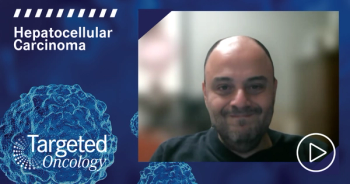
HCC: VEGF TKI Data and Treatment Selection
Episodes in this series

Richard S. Finn, MD: So lenvatinib comes along. It’s a very potent VEGF receptor inhibitor, but also has pretty broad activity against the fibroblast growth factor receptors—FGFRs 1 through 4. We talked about specific alterations in the FGF pathway, and molecular alterations that occur in liver cancer. But, there was a lot of interest for a while in targeting FGF as a resistance mechanism to VEGF, right? There was a drug, brivanib, being developed in the past that was felt to be a very attractive agent because it not only hit VEGF but it hit FGFRs as well.
The studies with brivanib did not meet their end points. However, we did see a head-to-head study, REFLECT, which was a pivotal study that got lenvatinib approved. It was a global study of over 900 patients. This was an open-label trial of sorafenib versus lenvatinib in the frontline setting. Again, as with all of our clinical studies, these were patients who had Child-Pugh A cirrhosis, well compensated. This head-to-head study was powered for noninferiority. We saw that lenvatinib actually met its end point. It did not meet the superiority end point.
Survival was around 13 months with lenvatinib, and about 12 months with sorafenib, and that translated into a hazard ratio of 0.92, I think. But the confidence interval overlapped 1. So this was not statistically significant for superiority, but the upper limit of that confidence interval was 1.06, which met the noninferiority end point—being under 1.08.
Based on these data, lenvatinib did get approved. What was interesting in the data set was that lenvatinib met its secondary end points. It improved progression-free survival versus sorafenib. Essentially, it almost doubled it. And also, we saw a reasonable response rate with a TKI [tyrosine kinase inhibitor.
The objective independent review RECIST response rate was just about 19% with lenvatinib. Historically, we saw sorafenib had some single-digit responses. And if you look at the modified RECIST response rate, which takes into account some of the enhancement characteristics, that response rate is around 24%.
We also know that lenvatinib and sorafenib have different adverse effect profiles. Lenvatinib has more of a hypertensive effect, and also the VEGF component of more proteinuria. Both drugs have similar amounts of GI [gastrointestinal] toxicity, including diarrhea, anorexia, and weight loss. However, sorafenib has more hand-foot skin syndrome. We really don’t see a significant percentage of hand-foot skin syndrome with lenvatinib, which I think is a differentiator that we consider when approaching our patients. Also, keep in mind the REFLECT study excluded patients who had tumors occupying more than 50% of their liver, or invasion of the portal vein outside the liver. But needless to say, we have 2 TKI options in the frontline setting that have some subtle differences.
Transcript edited for clarity.









































